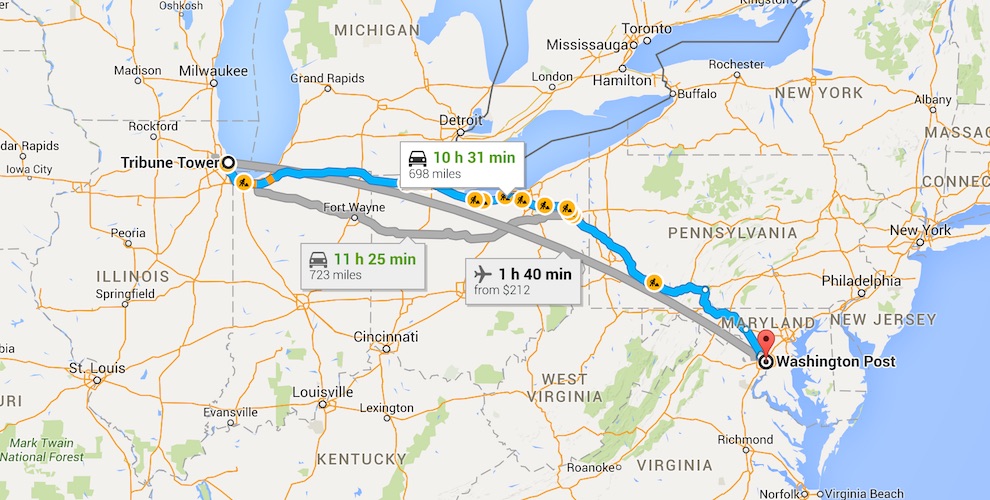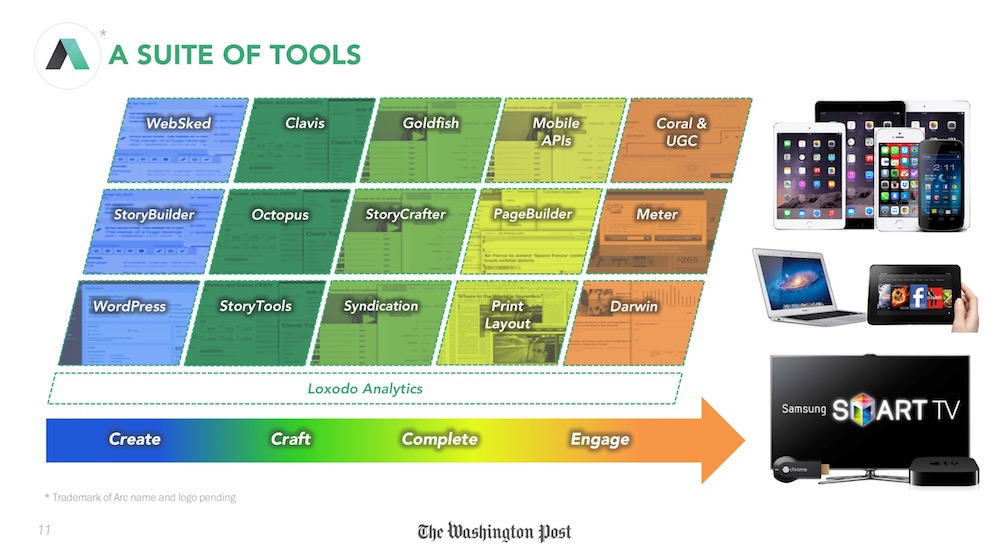
On Thursday, Tribune Publishing chairman Michael Ferro took to the airwaves, selling investors on his rejection of a seemingly generous takeover bid by Gannett. The company’s spent recent days talking up its potential for growth on its own — notably the planned “content monetization engine” it calls Tronc.
In this latest chapter of Tribune’s unbelievable saga — from Sam Zell to Jack Griffin to Ferro — the new boss invoked someone he knew would capture attention: Jeff Bezos.
That name now resonates across both tech and the news business. Bezos as Michael Ferro’s new partner? That would seem to bring instant legitimacy for the tech entrepreneur who just seized Tribune in a January coup and now fends off Gannett’s unwanted bear hug. Will that strategy work to push Gannett — and its offer to buy Tribune Publishing at a 63 percent premium to its before-bid share price — away?
He spoke both to Fox Business and to CNBC, telling the latter: “We are already working with the Post on bringing their CMS system to our company. We’ve already signed a beginning of a deal to bring Jeff’s system over to our newspaper. They’ve done a great CMS.” To Fox’s Neil Cavuto, he offered: “We’re upgrading our CMS, which is how you manage content. We’re using one from Jeff Bezos at The Washington Post. We are doing a deal with them to bring their CMS to us.”
Let’s consider that would-be Ferro/Bezos “partnership.” It may be less — or could become more — than meets the eye.
Like numerous CEOs and publishers who have visited The Washington Post with their CTOs in recent months, Ferro came away impressed with what he saw. Those industry execs have rotated the tires of Arc — the Post’s would-be next-generation, ready-to-be-licensed publishing platform that I first described here at the Lab in October (“The Washington Post offers an Arc in the storm.”Ferro knew he needed divert attention away from the financials his company had reported on Wednesday, down 7.5 percent year over year. He also needed to keep his board believing that he can somehow drive more financial value with his own ideas than shareholders could pocket quickly by accepting Gannett’s big offer.
Ferro worked his script well, the day after his company announced its board’s unanimous rejection of Gannett’s offer. And in associating with one of the few companies both investing in the new digital business and showing big gains, he harnessed a little of the Post’s and Arc’s growing credibility.
While the Post declined immediate comment on Ferro’s unexpected announcement of a partnership, I’ve been following Arc’s development since last fall. Its under-the-radar progress is significant. Today, Arc is in place at eight newspapers, most of them college-based ones, plus alternative weekly leader Willamette Week. I’ve also learned that the Post has signed contracts to put eight other publishers on Arc; all those are on schedule to launch by midyear or so. And later this month, the Post will announce its first daily newspaper client.
That Arc platform aims to provide the Post, and its growing licensees, a platform to power the modern business. That means individual modules that drive video, mobile, social, user testing, app creation and analytics, among other abilities. Those who have seen it like what they see, how it’s architected for integration and growth, even as they realize parts of it require fuller build-out.
Arc takes a cloud-based approach, hosted on Amazon Web Services — yet another leverage of that other little company in which Post owner Jeff Bezos is involved.

Arc includes Clavis, “an intelligence layer that drives personalization of both advertising [programmatic and native] and of reader preference,” Shailesh Prakash, the Post’s vice president of product and technology, told me earlier this spring. Clavis, in fact, sounds a lot like what Ferro has tried to describe as the basis of “artificial intelligence” theory of Tribune value creation.
The company Ferro took over is a tech laggard, and he sees Arc has a double solution. First, Tribune Publishing could replace its behind-the-curve publishing systems with it. Further, Arc could serve as the foundation for the outlined Tronc, or connected in some way to the Post’s Clavis. If Ferro and his CEO Justin Dearborn really intend to build an industry-leading, data-crunching business, it needs to be built upon very good publishing tech.
Wait a minute, though. Won’t this Tronc-upon-Arc (sounds like a delightful village in the Cotswolds, doesn’t it?) take a lot of time? And how much time does Michael Ferro really have?
That’s what adds the color here. Just as the embattled Ferro fights over a righteous and by-all-financial-lights winning merger bid from Gannett, he appears to want to bond with Bezos, hoping for a shield of genius.
Might that work? In a rational economic world, Gannett’s big bid for Tribune — valuing the stock at $12.25 a share when Ferro himself only paid $8.50 for it four months ago — would be a no-brainer. Ferro, though, is a self-styled tech genius (“Michael Ferro Uninterruptus: Can Gannett Pry The Talkative Tribune Head From His New Chair?”) and doesn’t want to lose his big chance to test out his theories on the news business.
Given that Tribune investors have started lining up for the Gannett deal, Ferro’s Bezos play would seem far-fetched. Yet for the wider industry, it’s a serious signal. Even a company as big as Tribune, America’s fourth largest newspaper company, is willing to finally acknowledge its inability to create, and update, a cost-efficient publishing system. Even if the Tribune/Post deal gets wiped out by a Gannett acquisition, that fact is noteworthy — and it’s not beyond the realm of possibility that Gannett could buy into Arc or part of its offerings. Arc’s impact on the news landscape — as publishers look every which way to cut costs permanently — will only grow in the rest of 2016 and into 2017.
About that buddy act, though: Should Tribune investors, or others, be impressed with Michael dropping Jeff’s name?
In fact, what Ferro is talking about is Tribune just becoming one of the Post’s Arc customers. It’s a product, and one transacted at the executive tech level. So it’s hardly the Michael-and-Jeff buddy act someone watching talk shows might have intuited.
But this is likely just a beginning step in the process, one that could lead to a larger Tribune Publishing embrace of Arc. In any event, given the magnitude of development, integration, and communication, replacing Tribune’s basic publishing platforms with Arc would take a year or more. And that’s before Tronc’s undeveloped “content monetization engine” could be even put into place. That’s why those leading newspaper tech generally speak to me of Ferro’s public plans as “smoke and mirrors.” They don’t dismiss the idea. It’s the little thing called execution to which they point.
Call it artificial intelligence, data science, or applied analytics, this larger notion is not one Ferro has invented for the news industry. In fact, the biggest and smartest news-producing companies are embracing it, busily hiring data scientists at off-the-charts salaries as fast as they can.
The formulas are similar: data mining meets targeting meets personalization. It’s business intelligence and everyone from the Financial Times to The New York Times to Dow Jones to Hearst is working on it. And, so is The Washington Post.
CEO Dearborn may have put a shine on Tronc as he explained it to the meager three financial analysts who deigned to participate in the earnings call. Tronc, he said, is “a transaction-based revenue business model that we believe allows us to leverage our massive content creation capabilities more effectively.” Why Tronc, now trademarked by Tribune? It’s a British expression for pooling tips, or more generally, pooling resources. (For a hilarious take on Tribune’s AI plans, don’t miss Jon Regardie’s parody of it, published in the L.A. Downtown News this week: “Inside Michael Ferro’s Secret Content Monetization Engine.”)
To Dearborn’s outline, the most advanced tech execs in the industry would nod their heads, and they say, “Yup, that’s what we already have in development.”
While Tribune’s top troika — who have no media experience among them, save Ferro’s four-year chairman role at the perpetually struggling Chicago Sun-Times — talk “billion-dollar” payoffs, all they have is a model. It’s like a kit to build one of those ships in a bottle.
It may be one fine ship, but, at this reading, it’s unlikely to be completed within the Tribune publishing vessel.